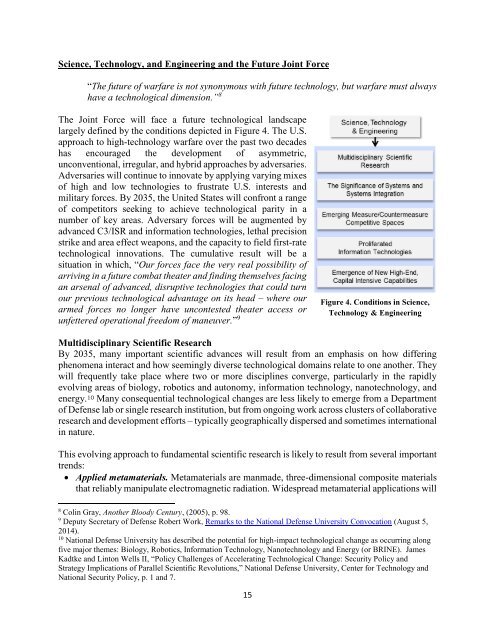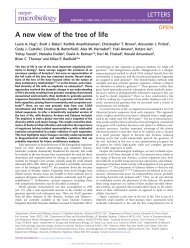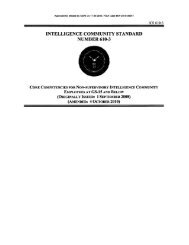The Joint Force in a Contested and Disordered World
JCS-JOE-2035
JCS-JOE-2035
Create successful ePaper yourself
Turn your PDF publications into a flip-book with our unique Google optimized e-Paper software.
Science, Technology, <strong>and</strong> Eng<strong>in</strong>eer<strong>in</strong>g <strong>and</strong> the Future <strong>Jo<strong>in</strong>t</strong> <strong>Force</strong><br />
“<strong>The</strong> future of warfare is not synonymous with future technology, but warfare must always<br />
have a technological dimension.” 8<br />
<strong>The</strong> <strong>Jo<strong>in</strong>t</strong> <strong>Force</strong> will face a future technological l<strong>and</strong>scape<br />
largely def<strong>in</strong>ed by the conditions depicted <strong>in</strong> Figure 4. <strong>The</strong> U.S.<br />
approach to high-technology warfare over the past two decades<br />
has encouraged the development of asymmetric,<br />
unconventional, irregular, <strong>and</strong> hybrid approaches by adversaries.<br />
Adversaries will cont<strong>in</strong>ue to <strong>in</strong>novate by apply<strong>in</strong>g vary<strong>in</strong>g mixes<br />
of high <strong>and</strong> low technologies to frustrate U.S. <strong>in</strong>terests <strong>and</strong><br />
military forces. By 2035, the United States will confront a range<br />
of competitors seek<strong>in</strong>g to achieve technological parity <strong>in</strong> a<br />
number of key areas. Adversary forces will be augmented by<br />
advanced C3/ISR <strong>and</strong> <strong>in</strong>formation technologies, lethal precision<br />
strike <strong>and</strong> area effect weapons, <strong>and</strong> the capacity to field first-rate<br />
technological <strong>in</strong>novations. <strong>The</strong> cumulative result will be a<br />
situation <strong>in</strong> which, “Our forces face the very real possibility of<br />
arriv<strong>in</strong>g <strong>in</strong> a future combat theater <strong>and</strong> f<strong>in</strong>d<strong>in</strong>g themselves fac<strong>in</strong>g<br />
an arsenal of advanced, disruptive technologies that could turn<br />
our previous technological advantage on its head – where our<br />
armed forces no longer have uncontested theater access or<br />
unfettered operational freedom of maneuver.” 9<br />
Figure 4. Conditions <strong>in</strong> Science,<br />
Technology & Eng<strong>in</strong>eer<strong>in</strong>g<br />
Multidiscipl<strong>in</strong>ary Scientific Research<br />
By 2035, many important scientific advances will result from an emphasis on how differ<strong>in</strong>g<br />
phenomena <strong>in</strong>teract <strong>and</strong> how seem<strong>in</strong>gly diverse technological doma<strong>in</strong>s relate to one another. <strong>The</strong>y<br />
will frequently take place where two or more discipl<strong>in</strong>es converge, particularly <strong>in</strong> the rapidly<br />
evolv<strong>in</strong>g areas of biology, robotics <strong>and</strong> autonomy, <strong>in</strong>formation technology, nanotechnology, <strong>and</strong><br />
energy. 10 Many consequential technological changes are less likely to emerge from a Department<br />
of Defense lab or s<strong>in</strong>gle research <strong>in</strong>stitution, but from ongo<strong>in</strong>g work across clusters of collaborative<br />
research <strong>and</strong> development efforts – typically geographically dispersed <strong>and</strong> sometimes <strong>in</strong>ternational<br />
<strong>in</strong> nature.<br />
This evolv<strong>in</strong>g approach to fundamental scientific research is likely to result from several important<br />
trends:<br />
Applied metamaterials. Metamaterials are manmade, three-dimensional composite materials<br />
that reliably manipulate electromagnetic radiation. Widespread metamaterial applications will<br />
8<br />
Col<strong>in</strong> Gray, Another Bloody Century, (2005), p. 98.<br />
9<br />
Deputy Secretary of Defense Robert Work, Remarks to the National Defense University Convocation (August 5,<br />
2014).<br />
10<br />
National Defense University has described the potential for high-impact technological change as occurr<strong>in</strong>g along<br />
five major themes: Biology, Robotics, Information Technology, Nanotechnology <strong>and</strong> Energy (or BRINE). James<br />
Kadtke <strong>and</strong> L<strong>in</strong>ton Wells II, “Policy Challenges of Accelerat<strong>in</strong>g Technological Change: Security Policy <strong>and</strong><br />
Strategy Implications of Parallel Scientific Revolutions,” National Defense University, Center for Technology <strong>and</strong><br />
National Security Policy, p. 1 <strong>and</strong> 7.<br />
15











